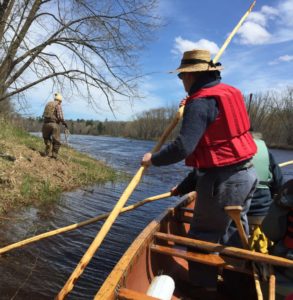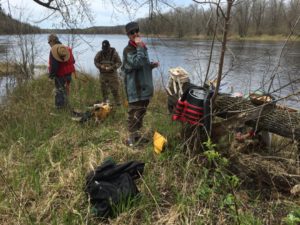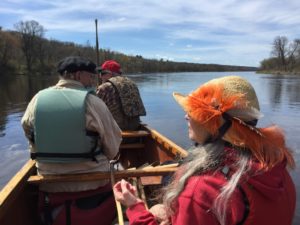In late April, 1805, John Sayer ascended the St. Croix River from the mouth of the Snake River to the mouth of the boiling Kettle River, en route northward and away from his wintering post. On almost the same day, two hundred and eleven years later, a crew of intrepid La Compagnie members traveled the same route in the Saint Pierre, our 26′ north canoe,
There were seven of us on the upstream leg of the journey: me, along with John, David, PatrickS, Tatjana, Linda and Steve. We faced fair skies but a gusty and stiff NE wind, some said later as much as 30 mph. After three inches of rain earlier in the week, the waters were running high, swift and clear of debris. At the late morning put-in, having pointed the craft upwind and upriver at the junction of the Snake and the St Croix, all of us paddling as hard we could could barely ferry across without being pulled downstream. It did not look like it would be a day of much progress.

Manning the poles from bow, midships and stern.John is our “mule,” pulling with the cordelle rope from the bow.
But as soon as we were upriver of the junction we could cordelle* the craft: John in waders with a tow rope at the bow, David in the bow poling, Patrick poling midships and Steve poling in the stern. It was a breeze—literally for the gals, as it was no use paddling as it drove the nose of the canoe too far from shore. And the long poles are too hazardous in motion to have more than three in action at once. So we peered into the glades observing the wakening spring flora, watched bird life and called out the coming boulders along the shoreline.
We speculated that, back in fur trade days, native gals would be walking on shore gathering spruce gum for the inevitable repairs to the bark canoe: the further upstream we got the rapids and rocks frequently littered the shoreline, as did sweepers and strainers (downed trees) and other natural obstacles. The fiberglass carapace of the Saint Pierre shrugged off these bumps; there were fewer rocks than expected as the river was running so high.

Lunch, with Dutchman’s breeches, trout lilies and spring beauty in bloom.
Lunch on an island in the lee of the wind was made even more pleasant by Dutchman’s breeches, trout lilies and spring beauty in bloom. Later a quiet narrow channel on the west bank led us to a un navigable small bay occupied by a half dozen huge soft shell turtles that slid into the water at our approach with loud thwack. We exited back to the gusts and eddies of the main channel.
By mid afternoon, we had reached the now-familiar spot that marks the mouth of the Kettle, a channel full of giant rocks and whitecap rapids. In 2015 we had made it this far, too, but on a very hot windless April day when thirst and boulders and ticks were our main challenges. So we ascended just a little further upstream to surpass last year’s mark, then backed the craft down, turned into the current and had a swift float (45 minutes!) back downstream to our camp and an evening meal of pea soup and rum.

Heading downstream, it was a constant struggle to not lift a paddle.
The next day, PatrickS and I departed by vehicle to shuttle camping gear from camp to landing. Thelma joined the group for the leisurely paddle back downstream to our starting point of the day before.
*Cordelle is form of corde, French for rope or cord. As a noun, it means a heavy rope used for towing boats on rivers; as a verb, to tow a boat by means of a rope.


33 years ago I was in that same canoe going down the Mississippi
to the Rendezvous. I have a lot of good memories from that trip.
Good to hear from you, Margaret! Saint Pierre has indeed seen hard service for many years and is still going strong. You’re always welcome to come paddle her again, any time we’re on the water.